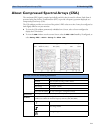
215
19
19Monitoring BIS
Bispectral Index monitoring helps to monitor the level of consciousness of a patient under general
anesthesia or sedation in the OR and ICU. The BIS sensor is placed on the patient’s forehead to
capture electroencephalographic (EEG) signals from which several numerics are derived, including a
single BIS value representing the level of consciousness. See the chapter on Specifications for the BIS
intended use statement.
The BIS Module or BIS Interface board (for MP20/MP30) provides the monitor with an EEG wave
and the following numerics:
Bispectral Index (BIS). The BIS numeric reflects the patient’s level of consciousness. It ranges from
100 (fully awake) to 0 (suppression; no electrical brain activity).
Signal Quality Index (SQI). The SQI numeric reflects signal quality and provides information about
the reliability of the BIS, SEF, TP, SR, and Bursts numerics during the last minute.
It ranges from 0 to 100%:
SQI < 15%: the numerics cannot be derived
SQI 15% to 50%: the numerics cannot be reliably derived
SQI 50% to 100%: the numerics are reliable.
Electromyographic Activity (EMG). The EMG numeric reflects the electrical power of muscle
activity and high frequency artifacts.
EMG < 55 dB: this is an acceptable EMG
EMG
≤ 30 dB: this is an optimal EMG
(note that the minimum possible EMG is approximately 25 dB).
Suppression Ratio (SR). The SR is the percentage of time over the last 63-second period during
which the EEG is considered to be in a suppressed state.
Spectral Edge Frequency (SEF). The SEF is the frequency below which 95% of the Total Power is
measured.
Total Power (TP). The TP numeric indicates the power in the frequency band 0.5 to 30 Hz. The
useful range is 30 - 100 dB.
Bursts (BISx module used with the Extend Sensor only) The Bursts numeric helps you quantify
suppression by measuring the number of EEG bursts per minute, where an EEG burst is defined as a
period of activity followed and preceded by inactivity (at least 0.5 second).


















